Did you know that Google doesn’t show all your pages in the search results, even though they have the potential to rank high? Yeah, that’s right! Your page is eligible to rank high, but doesn’t get displayed in the searches.
These are called omitted results and, although they aren’t something to freak out about, they can sometimes become a little bit of a pain. If your website is listed in Google’s omitted results, almost nobody will ever see it. Fortunately, there are some things you can do in order to get it out of there.
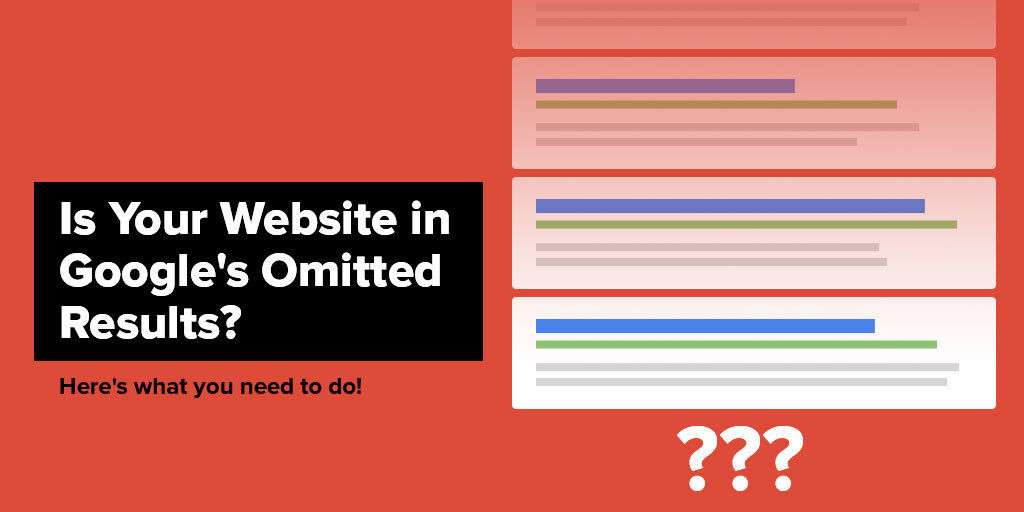
- What are omitted results?
- Why Does Google Omit Results from the Search?
- The Right Way to Make Omitted Results Reappear in the Search
- How NOT to Fix Omitted Results
We’ve seen some really bad information out there, so keep reading if you don’t want to completely destroy your rankings while trying to get your web page out of the omitted results! However, before we can diagnose the problem and fix it, we have to understand what omitted results are and why they exist.
What Are Omitted Results?
Omitted results are search results that are excluded from Google’s search pages in order to provide a better user experience.
These results usually provide information that is very similar to the information in another result that has already been displayed. They could be classified as duplicate content, but not necessarily.
They could also be classified as a defense mechanism against people trying to abuse the system and rank multiple pages on the same keyword. This technique would be a sort of reverse doorway pages, since doorway pages usually try to rank for multiple, different keywords.
To see omitted results you have to click until the last page of Google (for that particular query). This will basically tell Google ‘I haven’t found what I was searching for’ and Google will provide you with the omitted results message:
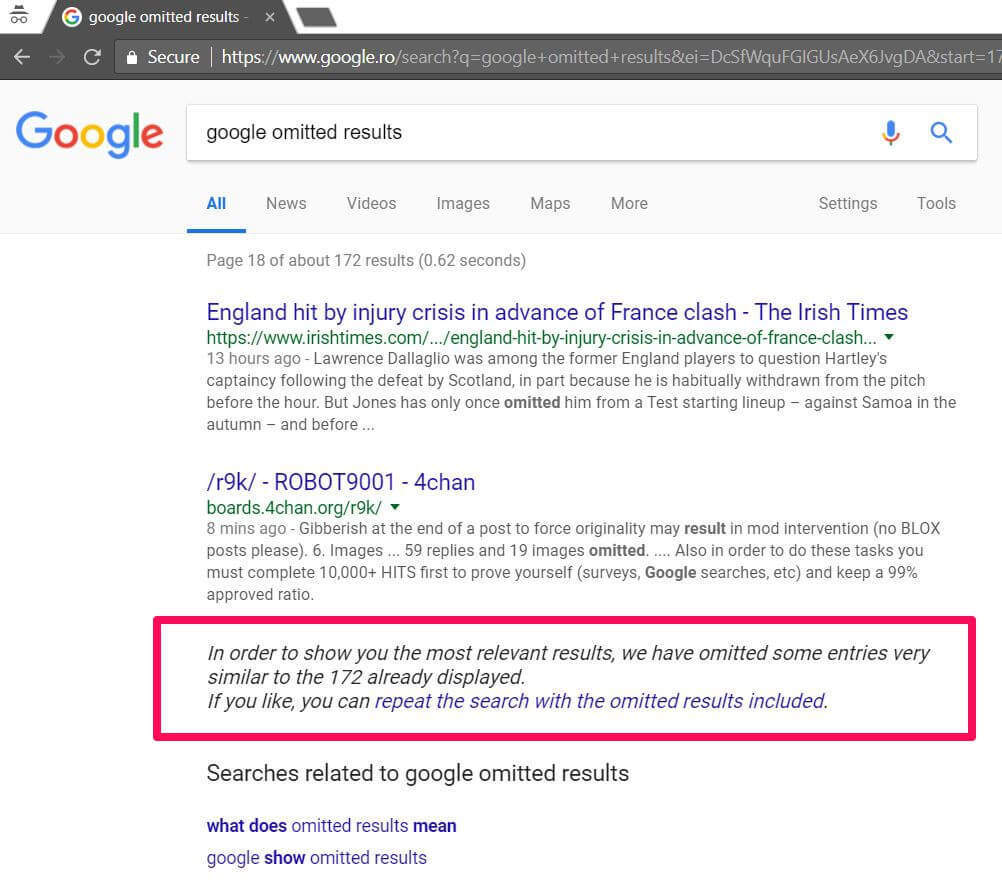
If you decide to repeat the search with the omitted results included, Google will display the first results page again, but this time you will be able to find some extra websites/pages around there.
I can recall seeing this omitted results message on previous pages in the past, but during my tests I wasn’t able to find an example. It’s probably not the case anymore. Sometimes, when you’re an SEO, you don’t know what’s real and what isn’t anymore.

There are two common scenarios where results might be omitted:
Omitted Results for Domains That Are Already Ranking
These are the kind of omitted results you probably worry less about. They occur when you have multiple pages addressing the same topic. Let’s say you have 3 forum pages about Tesla’s new Falcon Heavy rocket. They all pretty much cover the same topic, but have been posted by 3 different users. Google will basically have to choose which page is best, display that and omit the rest.
This doesn’t sound too bad, as you’re already ranking with one page at the top. Sure, it would be nice to cover multiple spots, but hey, at least you have one top position.
The problem, however, becomes a little bit more serious when you have thousands of pages all competing for the same keywords. If the number of pages competing for the same keyword starts getting really big, then Google might have trouble deciding what to show.
It’s a known fact that if you make a search engine’s job easier, it will repay you with rankings, so reducing the number of irrelevant pages is always a good idea.
If you want to display more than one result here, you’ll have to create two very different pages, providing a lot of value, with pretty much different titles and content, but still relevant to the topic. It’s not easy, is it? As there isn’t a guarantee that you’ll rank both, I’d spend my time building content to rank for other keywords.
Omitted Results for Domains That Are Not Already Ranking
Although I wasn’t able to find an example (more on that later), this is the true reason why this question actually pops up: You build a website or a page, only to find that your website only shows up in the omitted results.
Well, it might just be that your content is either very similar to the other ones that are already ranking, or that it doesn’t bring anything new to the table.
“But if the content is very similar, why is this happening to me? Why aren’t other websites shown in the omitted results and mine in the real results?”
Well, this has probably something to do with the domain age. Being a pioneer has always been hard, but when you make it, you succeed big time.
I don’t want to be dull, but the truth is you’ll have to provide a lot more value in order to get out of the omitted results.
You can’t just put a website out there and expect Google to rank it on top.
For this, you need to work. That’s what SEO is. If you want to get to the top really quick, you’ll have to advertise. If you’ve been copying the content, don’t even bother trying any other tricks. They won’t work!
Why Does Google Omit Results from the Search?
As I previously said, Google omits results in order to provide the user with the best possible experience. I know this is a little bit broad, but don’t worry, because I’ll explain everything in more detail.
Everything started with a lot of users complaining about Google pages returning a lot of results from the same domains, making the search experience a pretty bad one.
In the following video, Matt Cutts (former Head of Spam @ Google) is trying to explain why Google sometimes shows multiple results from the same domain:
In another video (which is a little bit older by the look of Matt’s hair color), Matt tries to explain how this actually works and how it has evolved over time. It seems like they’ve tested out every possibility until they reached a conclusion:
One thing is clear: users didn’t like to see a lot of results from the same domain, so they complained about it and Google had to do something about it.
For example, searching for ‘cheese calories’ in Romanian brings up 4 results from the same domain ranking up top, and then the results change. However, performing this search with the omitted results included only brings results from a single domain:
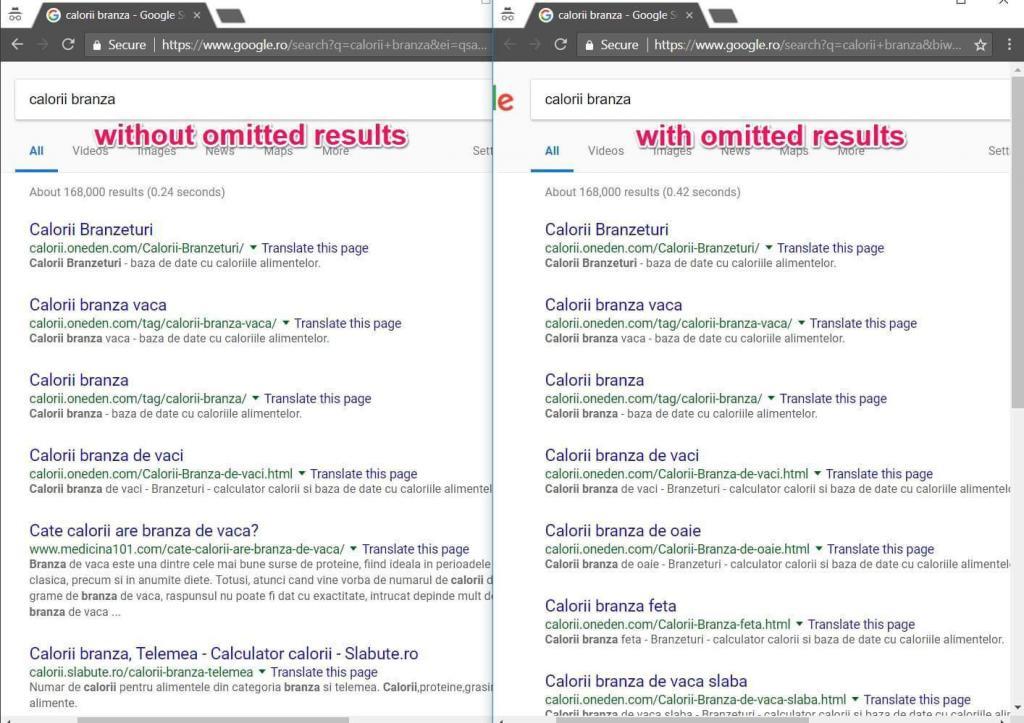
This is because that website has separate pages for different types of cheese, which makes them all compete with the query ‘cheese calories’. Wouldn’t the second results be a little bit disturbing for a user to see? It looks just like as that website hacked Google into ranking it everywhere.
Although it might seem that Google applied a clear limit on how many results from the same domain name can be shown in Google for a query, John Mueller (current Head of Spam @ Google) previously stated that there is no such limit:
There's no hard limit on # of times a site can appear in a search results page set.
— John ☆.o(≧▽≦)o.☆ (@JohnMu) May 23, 2017
Even if there is no limit, it’s clear that Google has been making efforts to not show the same domain over and over again when someone searches for something. Even Matt’s example in the video, regarding Hewlett Packard, fails to apply. Searching for ‘HP’ returns their primary domain, their Facebook page, a Wikipedia page and some news reports (all different domains). However, there are cases, like the one above with the calories, in which multiple listings from the same domain will be present.
In the end, it seems like the more pages you rank on a search query with the same domain, the harder it gets for another page from the same domain to rank on that query.
Testing this became really hard because, apparently, Google doesn’t always let you access the last page for a result. It’s probably an anti-spam measure, but that often left me frustrated, with broken Google pages in front of me.
What I’ve noticed during my tests is that although the warning message only shows up on the last page, the omitted results aren’t necessarily the last ones to be shown.
What does this mean?
It means that pages that are omitted from the search results can actually ‘rank’ higher than the ones that are already shown, but they are removed from the search before the results page gets displayed.
For example, if we had the following results, A, B, C and D, ranking in that exact order on the first page, then a result page with omitted results would display results A, B and D. Result C should be ranking higher than result D but, because of the fact that it’s very similar to website B (and probably a little bit less optimized, too), it disappears completely.
Although omitted results are usually pages from domains already ranking, it’s possible that a result will get omitted even if its domain isn’t already ranking with another page. This basically leaves you with no position in Google, drifting into the unknown, somewhere so far away that even the last page of Google would be better.
It’s highly probable that absolutely every search on Google omits some results. Due to the fact that there are millions of pages out there that might be targeting a certain topic, it’s impossible for Google to show them all. It would be useless anyway, as most users don’t even go past page two of Google.
There are many factors that can lead to your results being omitted, but the general idea is that your result, although relevant for the query, has already been covered by another already ranking result.
Google’s official statement on this is very exact and seems really simple to fix: just change the title and meta description and you’re done!
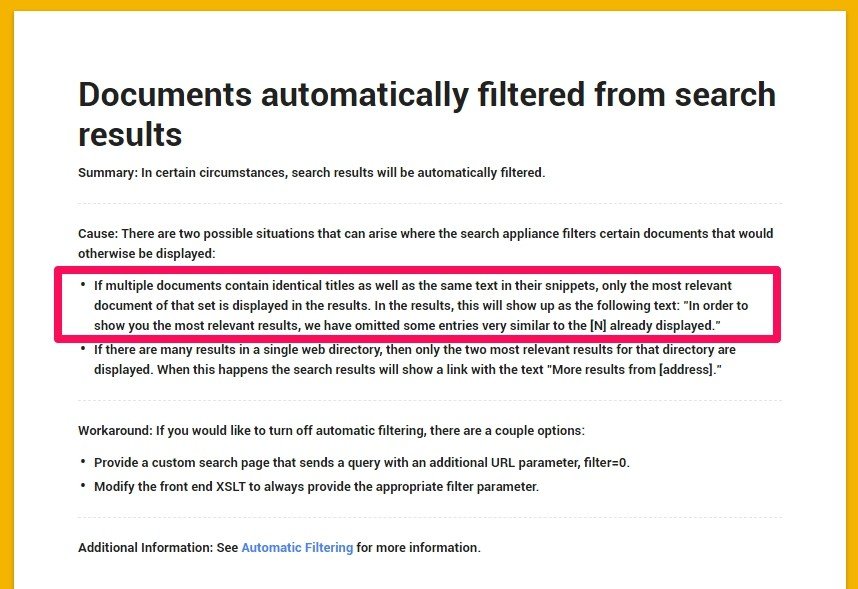
However, I’m going to bust that right away and prove that things aren’t that simple. Here’s an example for the search “how to deal with addiction”. The left side shows the regular search, while the right side shows the search with the omitted results included:
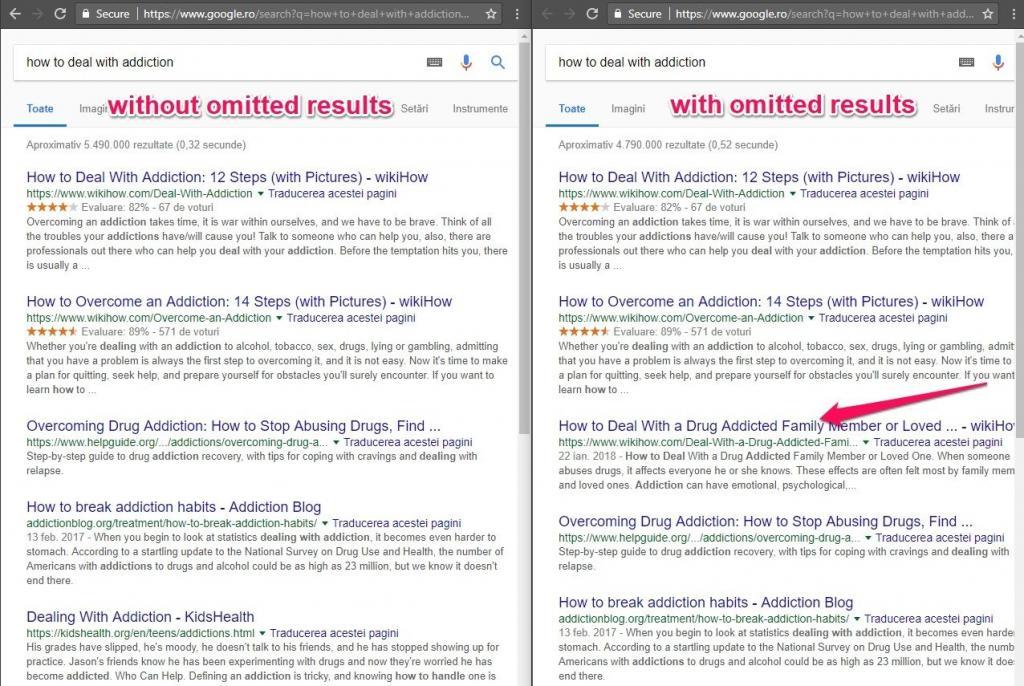
From what I can see, the first two results are very similar, while the third one is actually pretty different. Still, it has been omitted in the first search. I know it might not be the most relevant, but it definitely provides more information than the first two, which are pretty much the same thing.
This proves that Google might not always get it right and that getting out of the omitted results space might not be at a change of a title away.
Almost all cases of omitted results have something to do with duplicate content. All other SEO factors (such as page speed and backlinks) may play a role, but if the content really deserves to be there, Google will show it, even if it takes 2-3 seconds longer to load.
The Right Way to Make Omitted Results Reappear in the Search
First of all, consider that there are multiple ways your data can get unlisted from Google. Make sure this is not an indexation issue, by checking if your page is indexed. You can perform a Fetch and Render from the Google Search Console to tell Google to index your page.
Also, remember that the best cure to an illness is always prevention. Check these tips prior to building a website or a new page, as once your results have been omitted, it will be harder to get them out of there.
1. Check Your Website’s Architecture
You site’s architecture might lead to duplicate content issues, which will eventually force Google to omit search results from your website. Preventing this from happening can help you rank higher, as Google will appreciate you fixing these issues for it.
A common example is a hierarchy of categories and products, where products can be found in multiple categories. This will create different URLs with the same content, all competing for the same keywords. An easy fix would be placing the products in a separate subfolder such as /products/. This is also applicable to articles and blog categories. If you know your article is going to be found in multiple categories, it’s better to insert it’s URL slug right after the root domain instead of hierarchizing it after the categories.
Most CMS do this on their own, but custom platforms might encounter such situations.
If the pages are totally irrelevant, you may choose to remove them, block them from being indexed through the robots.txt file or mark them with a no-index meta tag. However, many of these pages might still have useful backlinks pointing to them, so it would be a far better idea to 301 redirect them to relevant locations, or use the rel=”canonical” meta tag to display the preferred page in the Google search results.
2. Improve Your Content and OnPage SEO
This is especially important if you’re not ranking with another page. It means that Google might think you’re just a copy-cat of already existing content.
A really good way of creating unique and robust content is by using the cognitiveSEO Keyword Tool & Content Assistant. The tool will provide you with interesting topics to add to your content in order to make it more relevant for a specific query.
Instead of writing new content on the same topic, consider improving old content with fresh information. This will maximize the potential to rank and reduce the chances of having duplicate content issues.
If you can’t really come up with something new in regards to content, then focus on improving the user’s experience through better site navigation, design and loading speed. You might not think so, but a theme can affect your On Page SEO big time. Make sure you fix all technical issues and try to identify all sorts of gaps in your competition’s websites that you can cover.
3. 301 redirects or rel=”canonical” meta tags
If you have a lot of pages that don’t provide much value to the website and you simply don’t need them anymore, you can 301 those to the most relevant locations. This way they will pass the link equity, if they had any.
A good example would be a very large website, with a huge amount of posts. At some point, it is inevitable that some topics will come up again and again. When too many articles are on the same topic, Google might start getting confused about which article from your website to show and choose instead to omit these articles from the search results. You could obviously delete some articles, but those articles actually have social shares and maybe even backlinks pointing back to your website.
You might also have pages that you want to be accessible from the website’s navigation, sidebar, footer or content, but don’t necessarily intend to rank them. These pages are very similar, but also different in some way. They are still relevant to your users when they navigate the website, but you don’t want them to be the ones to rank in Google. You can use the rel=”canonical” meta tag to tell Google which version to show in the search results. Using the canonical tag is like combining two pages into a single page in the search results.
4. Multiple Locations/Languages
Although this is still a duplicate content issue, the fix for it is rather different. It actually has nothing to do with multiple languages (because it requires a single language in order to happen), but it does have something to do with the hreflang meta tag.
Assume you have a product and you’re selling it in different regions. All these regions are English speaking regions, but the product pages are slightly different, therefore you have multiple pages with similar content:
domain.com/region1
domain.com/region2
domain.com/region3
etc.
The only difference in the titles for these pages will be the region. In order to prevent them from getting into the omitted results, make sure you properly add the hreflang meta tag. The hreflang meta tag will tell Google which page to show in which region. This way, Google will know exactly where to show each version, instead of having to figure it out all on its own.
The hreflang will look something like this:
<link rel=”alternate” hreflang=”en-us” href=”http://domain.com/region1” />
<link rel=”alternate” hreflang=”en-gb” href=”http://domain.com/region2” />
<link rel=”alternate” hreflang=”en-au” href=”http://domain.com/region3” />
How NOT to Fix Omitted Results
I’ve seen some articles out there that say that you should get rid of the omitted results, as if they were a cancer for your website. Well… that’s not actually true. At least not entirely. Those articles tell you to identify omitted results by searching your domain with the ‘site’ operator. The search would look like this in our case:
site:cognitiveseo.com
After you search, you will be presented with a list of all your pages that have been indexed by Google. Then, you need to reach the last page of Google, where the omitted results warning message usually appears. By comparing the results, you’ll be able to spot the ‘bad pages’.
The tutorial then suggests that you delete the results that have been omitted from your website.
I don’t think this is a good idea. While the results have been omitted, this is obviously something that’s happening for this specific query. Although this indicates that you have some duplicate/near duplicate content on your website, that doesn’t mean you should delete it.
This is something similar to the content pruning technique. While this might be useful for a website with a billion irrelevant and unused pages, in our case, here at cognitiveSEO, pruning the content didn’t have much of an impact.
Although content pruning won’t harm you in any way, identifying these pages with the method above isn’t a good idea. What if the omitted results are the ones that are actually more relevant to other specific queries? You’ll be deleting important pages this way.
Instead, use the method posted above and merge your content into a single more relevant piece by using 301 redirect or the rel=”canonical” meta tag. While the omitted results might not rank for the search ‘site:yourwebsite.com’, they might rank very well for other keywords. I’ll explain:
Let’s say that page A and page B both target keyword no. 1.
Unfortunately, page B get’s opted out and only shows in the omitted results for query no. 1.
Page A still ranks very well on keyword no. 1.
However, page B is also targeting keyword no. 2 through its content, while page A doesn’t. Keyword no. 1 has a lot more search volume, but keyword no. 2 also brings in a little bit of traffic.
Does deleting the page sound like a good idea now? Not so much, right?
Deleting omitted results from your website isn’t a very good idea. The results are omitted for a particular query, but might rank for other queries.
By using the canonical tag, you can tell Google that when someone searches for keyword no. 2, you want page A to show instead of page B. This makes sense, since the content of page B is already ranking. Using a 301 redirect is also a better solution than deleting the page completely because it will pass the link equity to page A. However, with a 301, page no. 2 will pretty much get deindexed so no page will be ranking for keyword no. 2 anymore. Use a 301 only if the page isn’t actually ranking well for any keywords.
Conclusion
Omitted results aren’t always something to freak out about, but they can indicate a growing issue on your website. You should deal with it as soon as possible by improving the quality of your content and making sure that you don’t write about the same topic over and over again. It’s always a better idea to improve old content rather than to build more mediocre content.
Have you had any experience with omitted results? If yes, have you managed to get out of there, or are your results still drowning? Let us know in the comments and maybe we can do something to help!
The post What to Do When Your Website Ends Up in Google’s Omitted Results appeared first on SEO Blog | cognitiveSEO Blog on SEO Tactics & Strategies.
What to Do When Your Website Ends Up in Google’s Omitted Results posted first on http://nickpontemarketing.tumblr.com/
No comments:
Post a Comment